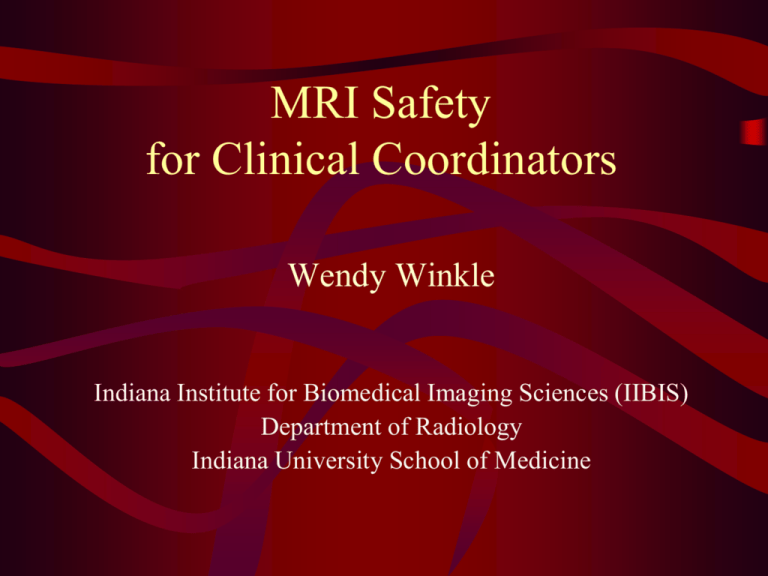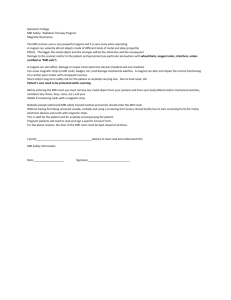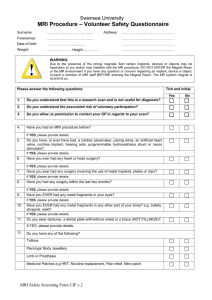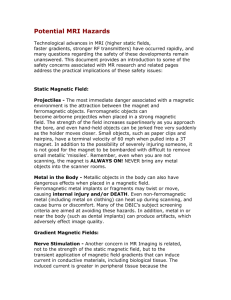Indiana Institute for Biomedical
advertisement

MRI Safety for Clinical Coordinators Wendy Winkle Indiana Institute for Biomedical Imaging Sciences (IIBIS) Department of Radiology Indiana University School of Medicine What is MRI? • MRI stands for Magnetic Resonance Imaging • Magnetic field and radio waves are used to create detailed pictures of anatomy noninvasively • Radio waves are directed at nuclei in this strong magnetic field. When the nuclei are excited then relaxed they emit a radio signal which can be measured and converted to an image. • MRI does not expose subjects to ionizing radiation and DOES NOT require Radiation Safety Approval Superconducting Magnet • Magnetic field is generated with current in wires made of superconducting material • No resistance at or near absolute zero – Cooled with liquid helium and nitrogen • Horizontal magnetic field = prone to missile effects MR Safety Considerations • The magnet is ALWAYS ON – even if we lose all electrical power in the building • Main considerations to prevent injury • People • Equipment • Other considerations to avoid inconvenience Danger! High Magnetic Field Restricted Zone Research Institute II – Basement Level 041-F 041-E 041-D Signs are posted outside of all MRI areas Types of MRI • The strength of the magnet is measured in Tesla (T) • Common clinical MRI system field strengths are .3, .7, 1, 1.5 & 3T • Open and Closed bore systems are available – Open systems are good for large or claustrophobic patients, but commonly have lower field strength and image quality may suffer – Closed systems are higher field strength and image quality is better in most cases Types of MRI OPEN BORE MRI CLOSED BORE MRI -courtesy of Siemens (VIVA) -courtesy of Siemens (3T TIM Trio) MRI of the Brain People Precautions Precautions for People Entering the Magnet Room • People with a pacemaker or that have previously had a pacemaker should not go in the restricted area. • People with implanted devices or prostheses should not enter the restricted area without physician clearance. Including but not limited to: – – – – Aneurysm clips, stents, cardiac defribillator Dental implants or devices Bone growth stimulators or orthopedic implants Implants for drug infusion or hearing Precautions for People Entering the Magnet Room • Pregnant Employees – Women that are pregnant, or suspect that they may be pregnant, should not go in the restricted area during the first trimester. – After the first trimester, they can go near the magnet but should not stay in the room during imaging procedures. Object Related Precautions Object Related Precautions • Magnetic materials can become airborne projectiles and pose life threatening danger – Small objects like paper clips, hair pins, jewelry, watches – Scissors, pens, needles and other medical, support or surgical equipment – Gas tanks and Cryogen dewers – Facilities equipment (mops, floor buffers, tools, etc) – Cellular phone, beepers, walky-talky Avoid Inconvenience • Credit cards, ID cards, cellular phone etc. may not work after exposure to significant magnetic field. • Do not take magnetic storage media, such as floppy disks, zip disks, magnetic tapes, laptops, etc. in the magnet room. Magnet Quench Magnet Quenching • Quenching is the process whereby a magnet suddenly loses magnetic field. – Instigated Quench – Spontaneous Quench • The magnetic field to blooms instantaneously. • The superconductive coils become resistive and cause heating. Cryogens boil off! • The helium and nitrogen from the magnet can replace oxygen in the room and cause asphyxia. Magnet Quenching • Cryogen vent – Vents cryogens to the outside of the building – Cryogen vents have failed • Oxygen monitor – The gas created when cryogens boil off is colorless and odorless • Leave the area immediately – If there is a smog in the area – Oxygen monitor alarms Instigated Magnet Quenching • Quench button can discharge the magnet in about 20 seconds. • Instigate a quench only when there is • Life threatening situation -A person is pinned to the magnet by a large object that cannot be removed by hand. • Large Fire – So that fire fighting personnel can safely enter the room. Magnet Quenching • Spontaneous or instigated quenching can cause severe or irreparable damage to the magnet coils and pose severe health risk – Boiling off of cryogens can cause asphyxiation – At least $50K to re-energize the magnet plus 1-2 month down time. – ~$2M if the magnet is irreparable. Quenched? A partially quenched horizontal bore NMR magnet. There is still enough field left to hold on to that gas tank, though! Photo Courtesy of William C. Stevens, Ph.D., NMR Facility Director, Southern Illinois University Emergency Procedures Life-threatening Emergency • Person pinned to the magnet by large object • Outbreak of Fire • Quench Person Pinned to Magnet • Notify MR personnel immediately • MR personnel will call for medical assistance • MR personnel will try to remove the object pinning the person • If the object cannot be removed – All leave the restricted area – Instigate quench Outbreak of Fire • Large Fires • Only professional fire fighters should attempt to extinguish. • All staff should leave the building. • Small Fires • Can be controlled by a staff member with a first aid fire extinguisher. • Must use non-ferromagnetic fire extinguisher and other equipment. Spontaneous Quench • Immediately leave the area! • Call MR personnel from a safe zone One cannot overemphasize safety around a MRI system Safety Policies MRI Safety Policies SUBJECT SAFETY • Any patient with an implanted device must have a card that states the model #, manufacturer and contact # so our technologists can verify safety of the device prior to the patient entering the MRI – Field Strength Specific – Protocol and/or Scan Time Specific • MR SAFETY QUESTIONNAIRE should be completed 24hrs prior to exam to allow time to verify safety before the subject arrives for the exam MRI Safety Policies SUBJECT SAFETY • Subjects answering negatively to questions on the MR SAFETY QUESTIONNAIRE may be excluded unless you have accounted for additional testing in your IRB – Ex. Subject was a metal worker & has had metal in their eye in the past. Clinical patients would receive an x-ray to exclude safety concern; however, a research subject should be excluded unless you account for the possible x-ray radiation exposure in your IRB MRI Safety Policies SUBJECT SAFETY • Medical attention even in an emergency should be administered outside the magnet room! • In the event a subject requires medical attention the MRI technologists will remove them from the magnet room on an MR compatible cart MRI Safety Policies GENERAL • An MR Safety Data Sheet must be completed by anyone entering the MR facility. • Coordinators and other support staff are not allowed in the magnet room unless accompanied by MR personnel. – There are exceptions to this rule if the staff undergo MR safety training and have permission of the facility director or their designee. MRI Safety Policies GENERAL • Always remove all items from your person, pockets and belt before entering • MRI Tech or MR Physicist will test equipment and devices prior to taking them into the magnet room with a powerful handheld magnet • Equipment and devices not certified MRI SAFE must be cleared by the Research MRI Safety Committee prior to study start Website Offers Help! • For assistance with regulatory risk wording visit the Office for Research Imaging website: www.ori.medicine.iu.edu Into the Bore They Go! All images and information courtesy of Magmedix website: http://www.magmedix.com An industrial floor polisher was taken into the MRI room by facilities personnel. Within seconds it was drawn into the bore of the magnet. A pallet jack was located within the 5 Gauss line of the magnet. Into the bore it went - You wouldn’t want to stand in the way of this! This shows what can happen when a welding tank is brought near a magnet. The flying tank destroyed a phantom that was sitting in the bore. Repairman injured in bizarre MRI machine accident A Houston repairman is hospitalized after a bizarre accident with an MRI machine. ABC13 Eyewitness News (2/12/03) — A repairman may have broken his arm in a freak accident where a piece of metal pinned him to an MRI machine. Cy-Fair volunteer firefighters were called to the Steeplechase Diagnostic Center after the magnetic force of the machine caught the repairman. Why? Because he carried a piece of steel into an imaging room. "The magnetic field will grab a hold of any steel objects, metal objects and the field is very strong," said business owner Lance Rickey. "So obviously, as what happened here tonight, he was pulled into the magnet and pinned there." Rescuers finally freed the repairman by releasing the magnets' cooling helium, breaking the machine's hold on the metal. The repairman was taken by LifeFlight to Memorial Hermann Hospital. Courtesy of ABCNews.com Hospital Nightmare Boy, 6, Killed in Freak MRI Accident July 31, 2002 — A 6-year-old boy died after undergoing an MRI exam at a New York-area hospital when the machine's powerful magnetic field jerked a metal oxygen tank across the room and into the magnet where the child was located. Employees of the Westchester Medical Center in Valhalla, N.Y., gather outside after learning of the deadly MRI incident. (ABCNEWS.com) Courtesy of ABCNews.com






